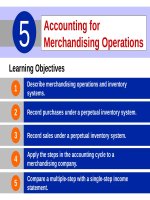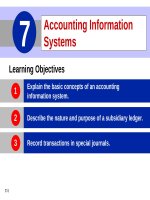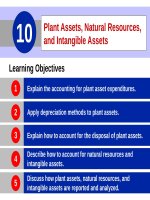Accounting principles 10e by kieso chapter 13
Bạn đang xem bản rút gọn của tài liệu. Xem và tải ngay bản đầy đủ của tài liệu tại đây (1.68 MB, 60 trang )
13-1
CHAPTER13
Corporations:
Organization and
Capital Stock
Transactions
13-2
PreviewofCHAPTER13
13-3
The Corporate Form of Organization
An entity separate and distinct from its owners.
Classified by Purpose
Classified by Ownership
Not-for-Profit
Publicly held
For Profit
Privately held
►
Salvation Army
►
McDonald’s
►
American Cancer
Society
►
Nike
►
PepsiCo
►
13-4
►
Cargill Inc.
Characteristics of a Organization
Characteristics that distinguish corporations from
proprietorships and partnerships.
13-5
Separate Legal Existence
Limited Liability of Stockholders
Transferable Ownership Rights
Ability to Acquire Capital
Continuous Life
Government Regulations
Additional Taxes
Corporate Management
Advantages
Disadvantages
SO 1 Identify the major characteristics of a corporation.
Characteristics of a Organization
Characteristics that distinguish corporations from
proprietorships and partnerships.
13-6
Separate Legal Existence
Limited Liability of Stockholders
Transferable Ownership Rights
Ability to Acquire Capital
Continuous Life
Government Regulations
Additional Taxes
Corporate Management
Corporation acts
under its own name
rather than in the
name of its
stockholders.
SO 1 Identify the major characteristics of a corporation.
Characteristics of a Organization
Characteristics that distinguish corporations from
proprietorships and partnerships.
13-7
Separate Legal Existence
Limited Liability of Stockholders
Transferable Ownership Rights
Ability to Acquire Capital
Continuous Life
Government Regulations
Additional Taxes
Corporate Management
Limited to their
investment.
SO 1 Identify the major characteristics of a corporation.
Characteristics of a Organization
Characteristics that distinguish corporations from
proprietorships and partnerships.
13-8
Separate Legal Existence
Limited Liability of Stockholders
Transferable Ownership Rights
Ability to Acquire Capital
Continuous Life
Government Regulations
Additional Taxes
Corporate Management
Shareholders may
sell their stock.
SO 1 Identify the major characteristics of a corporation.
Characteristics of a Organization
Characteristics that distinguish corporations from
proprietorships and partnerships.
13-9
Separate Legal Existence
Limited Liability of Stockholders
Transferable Ownership Rights
Ability to Acquire Capital
Continuous Life
Government Regulations
Additional Taxes
Corporate Management
Corporation can
obtain capital
through the issuance
of stock.
SO 1 Identify the major characteristics of a corporation.
Characteristics of a Organization
Characteristics that distinguish corporations from
proprietorships and partnerships.
13-10
Separate Legal Existence
Limited Liability of Stockholders
Transferable Ownership Rights
Ability to Acquire Capital
Continuous Life
Government Regulations
Additional Taxes
Corporate Management
Continuance as a
going concern is not
affected by the
withdrawal, death, or
incapacity of a
stockholder,
employee, or officer.
SO 1 Identify the major characteristics of a corporation.
Characteristics of a Organization
Characteristics that distinguish corporations from
proprietorships and partnerships.
13-11
Separate Legal Existence
Limited Liability of Stockholders
Transferable Ownership Rights
Ability to Acquire Capital
Continuous Life
Government Regulations
Additional Taxes
Corporate Management
SO 1 Identify the major characteristics of a corporation.
Characteristics of a Organization
Characteristics that distinguish corporations from
proprietorships and partnerships.
13-12
Separate Legal Existence
Limited Liability of Stockholders
Transferable Ownership Rights
Ability to Acquire Capital
Continuous Life
Government Regulations
Additional Taxes
Corporate Management
Corporations pay
income taxes as a
separate legal entity
and in addition,
stockholders pay
taxes on cash
dividends.
SO 1 Identify the major characteristics of a corporation.
Characteristics of a Organization
Characteristics that distinguish corporations from
proprietorships and partnerships.
13-13
Separate Legal Existence
Limited Liability of Stockholders
Transferable Ownership Rights
Ability to Acquire Capital
Continuous Life
Government Regulations
Additional Taxes
Corporate Management
Separation of
ownership and
management
prevents owners
from having an
active role in
managing the
company.
SO 1 Identify the major characteristics of a corporation.
Characteristics of a Organization
Stockholders
Illustration 13-1
Corporation
organization chart
Chairman and
Board of
Directors
President and
Chief Executive
Officer
General
Counsel and
Secretary
Vice President
Finance/Chief
Financial Officer
Vice President
Marketing
Treasurer
13-14
Vice President
Operations
Vice President
Human
Resources
Controller
SO 1 Identify the major characteristics of a corporation.
Forming a Corporation
Initial Steps:
Formed by grant of a state charter.
Corporation develops by-laws.
Companies generally incorporate in a state whose laws are
favorable to the corporate form of business (Delaware, New
Jersey).
Corporations expense organization costs as incurred.
13-15
SO 1 Identify the major characteristics of a corporation.
Ownership Rights of Stockholders
Stockholders have the right to:
Illustration 13-3
1. Vote in election of board of
directors and on actions that
require stockholder approval.
2. Share the corporate earnings
through receipt of dividends.
13-16
SO 1 Identify the major characteristics of a corporation.
Ownership Rights of Stockholders
Stockholders have the right to:
Illustration 13-3
3. Keep the same percentage ownership when new
shares of stock are issued (preemptive right *).
* A number of companies have eliminated the preemptive right.
13-17
SO 1 Identify the major characteristics of a corporation.
Ownership Rights of Stockholders
Stockholders have the right to:
Illustration 13-3
4. Share in assets upon liquidation in proportion to
their holdings. This is called a residual claim.
13-18
SO 1 Identify the major characteristics of a corporation.
Ownership Rights of Stockholders
Prenumbered
Illustration 13-4
Class
Class A
Class A
COMMON STOCK
COMMON STOCK
PAR VALUE
$1 PER SHARE
PAR VALUE
$1 PER SHARE
Name of corporation
Stockholder’s name
Stock Certificate
Shares
Signature of corporate
official
13-19
SO 1
Stock Issue Considerations
Authorized Stock
13-20
Charter indicates the amount of stock that a
corporation is authorized to sell.
Number of authorized shares is often reported in the
stockholders’ equity section.
SO 1 Identify the major characteristics of a corporation.
Stock Issue Considerations
Issuance of Stock
Corporation can issue common stock directly to investors
or indirectly through an investment banking firm.
Factors in setting price for a new issue of stock:
1. Company’s anticipated future earnings.
2. Expected dividend rate per share.
3. Current financial position.
4. Current state of the economy.
5. Current state of the securities market.
13-21
SO 1 Identify the major characteristics of a corporation.
Stock Issue Considerations
Market Value of Stock
13-22
Stock of publicly held companies is traded on organized
exchanges.
Interaction between buyers and sellers determines the
prices per share.
Prices tend to follow the trend of a company’s earnings and
dividends.
Factors beyond a company’s control, may cause day-today fluctuations in market prices.
SO 1 Identify the major characteristics of a corporation.
13-23
Stock Issue Considerations
Par and No-Par Value Stock
13-24
Years ago, par value determined the legal capital per share
that a company must retain in the business for the
protection of corporate creditors.
Today many states do not require a par value.
No-par value stock is quite common today.
In many states the board of directors assigns a stated
value to no-par shares.
SO 1 Identify the major characteristics of a corporation.
Corporate Capital
Common
CommonStock
Stock
Paid-in
Paid-inCapital
Capital
Account
Account
Preferred
PreferredStock
Stock
Paid-in
Paid-inCapital
Capitalinin
Excess
Excessof
ofPar
Par
Account
Account
Account
Account
Two Primary
Sources of
Equity
Retained
RetainedEarnings
Earnings
Account
Account
Paid-in capital is the total amount of cash and other assets paid
in to the corporation by stockholders in exchange for capital
stock.
13-25
SO 2 Differentiate between paid-in capital and retained earnings.









